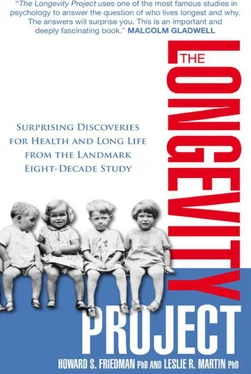Although it may seem counterintuitive, the first thing we needed to do was to see if the child was the problem. We knew that unconscientious children and those who had certain other characteristics in the “untamed” direction (i.e., impulsiveness and moodiness) were less likely to live long lives. So perhaps it was Donna’s unconscientious acting-out that was both driving her parents to divorce and then leading to her own early demise. Or, to put it bluntly, it would be Donna’s fault not her parents’ fault. If true, this would be important to know, because it would mean that parental divorce was not playing a causal role in the later premature deaths of these Terman children.
We found that the effects of childhood personality and the effects of experiencing the parents’ divorce were not related to each other. Each was an independent health risk factor. The problem emerging from stressed families was not in fact coming from the children. In addition, although serious illness or serious disability of a child can cause strain on a marriage, that was not what was going on in Dr. Terman’s sample of 1,528 bright and generally healthy children.
Marriage and divorce have different meanings for males and females, so we separated our statistical analyses by sex. With then- graduate student Joan Tucker leading the way, we pulled out the death certificates we had gathered and checked the causes of death. Things were indeed different for boys than for girls. We found that the men who, as children, had faced parental divorce were especially likely to die of accidents or violence, suggesting they grew up to be more reckless. But both the men and the women who had faced parental divorce were also more likely to die sooner from all other causes, including cancer and heart attack and stroke. In other words, parental divorce was a general and powerful risk factor, especially relevant to death from injury but also relevant to death from disease.
Divorce can drastically alter a family’s finances, and so we wondered if financial hardship was promoting long-term risks following a divorce. Although the Terman participants were mostly middle class, there were variations in socioeconomic status (measured by a combination of income, occupation, and education). As a whole, divorce tended to lower the children’s standard of living, but individual differences among families were evident. Donna’s mother was able to become self-sufficient rather quickly, while Philip’s mother struggled financially until he left home. Looking at the group as a whole, we discovered that a plunge in childhood socioeconomic status did make a difference for some of these children of divorce, especially for the girls. But surprisingly, other factors were much more important. Discovering the true pathways to long life revealed that a solution to this threat would not be primarily economic.
The Real Problem with Parental Divorce
How did the children of divorce differ from the children from intact families once they had all grown up? We wondered if the two groups had achieved different educational levels. Indeed, one difference was that both boys and girls from divorced homes tended to end their education earlier than those from intact families—many were discouraged and had fallen off the track of upward mobility. This handicap affected not only their future income but also their overall career accomplishments. The gap made a difference for boys, helping to explain part of their increased mortality risk. Men were expected, during the Terman era, to be the head of the family. Less accomplishment limited their ability to do this effectively, decreasing their status in adulthood and increasing their stress-filled behavior patterns and their risk of dying. The disadvantage was less important for the Terman girls, probably because women during this time period weren’t expected to focus as much on work and other activities outside the home.
Heavy drinking and smoking are, of course, significant health risks, and children of divorce, it turned out, engaged in these practices more than Terman subjects from intact homes. This was especially true of smoking. Only a quarter of the men from divorced families never smoked, compared to over a third of the men from intact families. For women, the differences were especially dramatic: women from intact families were more than twice as likely to avoid smoking as those whose parents divorced. And women from divorced families were more than twice as likely to be heavy smokers. Donna, something of a tomboy and rebel, began smoking immediately upon entering college and kept it up for the rest of her life.
Taking into account how much women from divorced families smoked is very useful in explaining their greater mortality risk—the early shattering of their family security predicted a more dangerous lifestyle over the long term. Whereas other researchers had confirmed increased short-term risk for the children of divorce, our findings pointed to the very real long-term impacts. The findings are also consistent with epidemiological studies showing that offspring of divorced parents have increased cancer risks, especially cancers related to tobacco, alcohol, and sexual promiscuity. 38 38 For a study on parental divorce and cancer see K. Hemminki and B. Chen, “Lifestyle and Cancer: Effect of Parental Divorce,” European Journal of Cancer Prevention 15, no. 6 (2006): 524-30.
But even smoking and drinking were not the major key to understanding the increased risk of dying for people like Donna and Philip.
Those who had lived through a divorce as children were much more likely to get divorced themselves. And these later disruptions in their relationships placed them at significantly greater mortality risk. This pattern was especially damaging for men. Uncovering this link was one of our most important findings.
The pattern played out for both Philip and Donna. Donna, who managed to balance a successful career with mothering two active sons, wasn’t able to hold her own marriage together. The boys stayed with her, and, like her own divorced mother, Donna was able to provide a stable transition and financial security for them as they grew. But with her unstable childhood, her divorce, and the demands of her job, she was unable to maintain a close circle of friends. She couldn’t quit smoking, couldn’t maintain her weight, and died of lung cancer.
Philip’s marriage also ended in divorce, soon after his return from the Pacific in World War II. It’s hard to say to what extent his divorce stemmed from the separation and stresses of war versus from his previous experience with the marital discord of his parents. What we do know is that, whatever the reasons behind it, divorce was a major health risk factor for him and for many of the Terman participants. One key problem was that those who had experienced parental divorce reported fewer group memberships and poorer community relations when they themselves became adults. We will return to this important topic later in this book when we discuss the health and long life significance of stable relationships and certain kinds of social ties.
Despite the very real risks associated with parental divorce, there were many Terman children, such as Patricia and James, who experienced the divorce of their parents and went on to live long lives. It is probably an exaggeration to say that some of the Terman participants were like a phoenix rising, but what enabled some of these individuals to manage, and even thrive, in the face of adversity? Most studies would be unable to follow up and see what was helpful. But due to the tremendous efforts of Terman and his colleagues and successors, we could undertake just such a study.
Читать дальше











